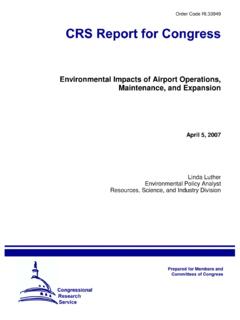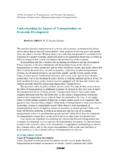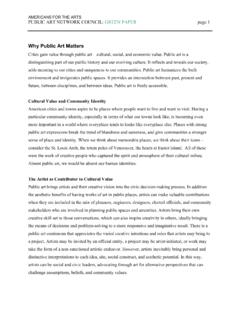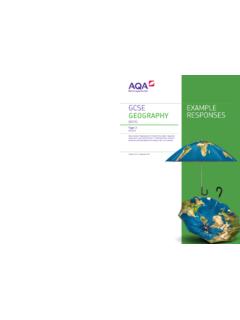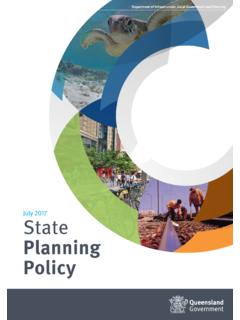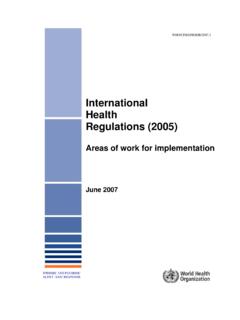Transcription of Mark scheme: Paper 2 Challenges in the human environment ...
1 SPECIMEN ASSESSMENT MATERIAL GCSE GEOGRAPHY Paper 2 Challenges IN THE human environment mark scheme Specimen mark scheme GCSE GEOGRAPHY Paper 2 SAMS 2 Mark schemes are prepared by the Lead Assessment Writer and considered, together with the relevant questions, by a panel of subject teachers. This mark scheme includes any amendments made at the standardisation events which all associates participate in and is the scheme which was used by them in this examination. The standardisation process ensures that the mark scheme covers the students responses to questions and that every associate understands and applies it in the same correct way. As preparation for standardisation each associate analyses a number of students scripts. Alternative answers not already covered by the mark scheme are discussed and legislated for.
2 If, after the standardisation process, associates encounter unusual answers which have not been raised they are required to refer these to the Lead Assessment Writer. It must be stressed that a mark scheme is a working document, in many cases further developed and expanded on the basis of students reactions to a particular Paper . Assumptions about future mark schemes on the basis of one year s document should be avoided; whilst the guiding principles of assessment remain constant, details will change, depending on the content of a particular examination Paper . Further copies of this mark scheme are available from mark scheme GCSE GEOGRAPHY Paper 2 SAMS 3 Level of response marking instructions Level of response mark schemes are broken down into levels, each of which has a descriptor.
3 The descriptor for the level shows the average performance for the level. There are marks in each level. Before you apply the mark scheme to a student s answer read through the answer and annotate it (as instructed) to show the qualities that are being looked for. You can then apply the mark scheme . Step 1 Determine a level Start at the lowest level of the mark scheme and use it as a ladder to see whether the answer meets the descriptor for that level. The descriptor for the level indicates the different qualities that might be seen in the student s answer for that level. If it meets the lowest level then go to the next one and decide if it meets this level, and so on, until you have a match between the level descriptor and the answer. With practice and familiarity you will find that for better answers you will be able to quickly skip through the lower levels of the mark scheme .
4 When assigning a level you should look at the overall quality of the answer and not look to pick holes in small and specific parts of the answer where the student has not performed quite as well as the rest. If the answer covers different aspects of different levels of the mark scheme you should use a best fit approach for defining the level and then use the variability of the response to help decide the mark within the level, ie if the response is predominantly level 2 with a small amount of level 3 material it would be placed in level 2 but be awarded a mark near the top of the level because of the level 3 content. Step 2 Determine a mark Once you have assigned a level you need to decide on the mark. The descriptors on how to allocate marks can help with this. The exemplar materials used during standardisation will help.
5 There will be an answer in the standardising materials which will correspond with each level of the mark scheme . This answer will have been awarded a mark by the Lead Examiner. You can compare the student s answer with the example to determine if it is the same standard, better or worse than the example. You can then use this to allocate a mark for the answer based on the Lead Examiner s mark on the example. You may well need to read back through the answer as you apply the mark scheme to clarify points and assure yourself that the level and the mark are appropriate. Indicative content in the mark scheme is provided as a guide for examiners. It is not intended to be exhaustive and you must credit other valid points. Students do not have to cover all of the points mentioned in the Indicative content to reach the highest level of the mark scheme .
6 An answer which contains nothing of relevance to the question must be awarded no marks . Assessment of spelling, punctuation and grammar (SPaG) Accuracy of spelling, punctuation, grammar and the use of specialist terminology will be assessed via the indicated 9 mark questions. In each of these questions, three marks are allocated for SPaG as follows: High performance 3 marks Intermediate performance 2 marks Threshold performance 1 mark mark scheme GCSE GEOGRAPHY Paper 2 SAMS 4 Qu Part Marking guidance Total marks Question 1 Urban issues and Challenges 01 1 Only credit differences between Africa and South America, although these may be implied. Two separate differences should be described. Credit use of the key to state specific figures, where relevant, eg the percentage of population living in urban settlements is greater in South America than in Africa (1) there is greater variation in the percentage of urban population in Africa than in South America, where figures are more uniform (1) many countries (approximately 20) in Africa have less than 40% of the population living in urban settlements compared with only one in South America (1).
7 No credit for descriptions of other continents or of global patterns. AO4 = 2 marks 2 01 2 One mark for each correct answer: B The urban population grew more rapidly than the rural population between 1950 and 2000 D The urban population increased by over 2000 million between 1950 and 2010. No credit if three or more statements are shaded. AO4 = 2 marks 2 01 3 Must refer to two reasons for slow urban growth rates, which can be implied, eg in many HICs the process started earlier than LICs and NEEs so the vast majority of people moved to the cities when industry was developing (1) many cities are already overcrowded in HICs so some people are tending to move to rural areas (1) in some HICs, inner city industries collapsed, resulting in large scale unemployment. People wanted a better quality of life and to be able to live in a clean and quiet rural area (1) it has become easier in many HICs for people to commute to work or work remotely from home in rural areas, using internet/email technology (1).
8 AO2 = 2 marks 2 mark scheme GCSE GEOGRAPHY Paper 2 SAMS 5 01 4 Level marks Description 3 (Detailed) 5-6 AO3 Demonstrates thorough application of knowledge and understanding to the issue of opportunities for people in urban areas in LICs and/or NEEs. AO3 Demonstrates reasoned evaluation of the extent to which urban areas in LICs or NEEs provide social and economic opportunities for people. 2 (Clear) 3-4 AO1 Shows clear and accurate knowledge of places and processes in urban environments. AO2 Demonstrates sound understanding of how urban areas provide both social and economic opportunities. 1 (Basic) 1 2 AO1 Shows limited and partially accurate knowledge of places and processes in urban environments. AO2 Demonstrates some understanding of how urban areas provide both social and/or economic opportunities.
9 0 No relevant content. Indicative content Emphasis should be placed on social and economic opportunities. No direct credit for environmental aspects unless they impinge on living standards/economic opportunities. The command to what extent requires an appraisal of the degree to which urban areas in LICs/NEEs provide social and economic opportunities for people. Answers may refer to a named city (although this is not essential) such as Rio de Janeiro in Brazil where people can earn more money and have regular jobs. Construction provides a big source of employment for large numbers of unskilled workers, and many work in manufacturing, such as food, and making shoes and textiles. People can then afford to have better housing, which includes a clean water supply, sanitation and electricity.
10 This increases the chance of a healthier life and reduces the risk of disease. Urban areas also have education and health opportunities; children can go to school, which gives them a better opportunity to get a job. Credit responses which take the view that opportunities are restricted and that there is often a mismatch between perceived opportunities and the reality of life in urban areas in LICs or NEEs. Unplanned urbanisation may bring risk of social instability, pressure on infrastructure, potential water crises and the potential for spread of disease. 6 mark scheme GCSE GEOGRAPHY Paper 2 SAMS 6 While moving to a city offers people more opportunities to improve their living conditions, the high cost of living and competition for jobs can also trap people in poverty.











